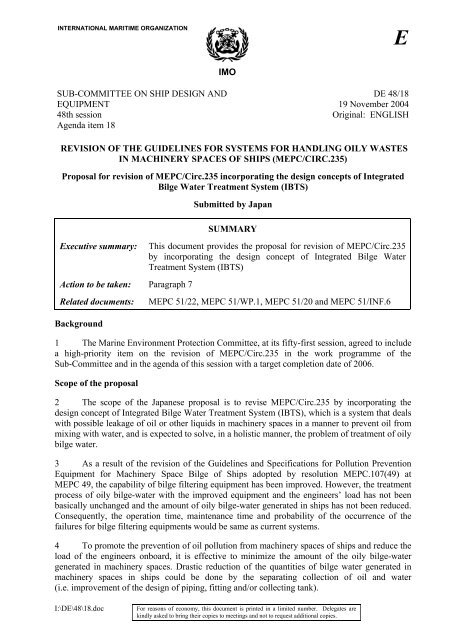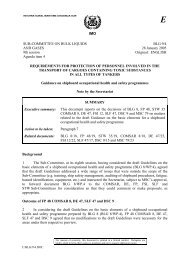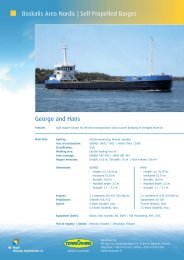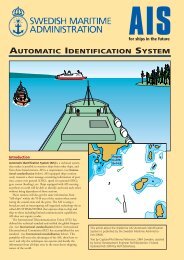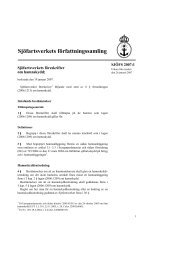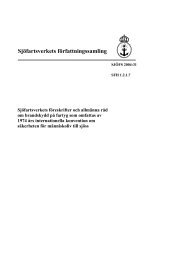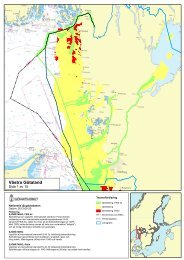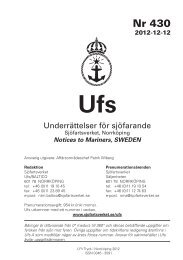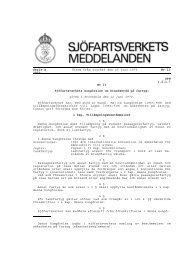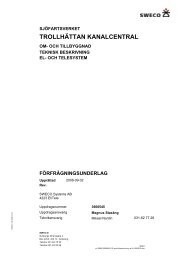IMO SUB-COMMITTEE ON SHIP DESIGN AND EQUIPMENT 48th ...
IMO SUB-COMMITTEE ON SHIP DESIGN AND EQUIPMENT 48th ...
IMO SUB-COMMITTEE ON SHIP DESIGN AND EQUIPMENT 48th ...
Create successful ePaper yourself
Turn your PDF publications into a flip-book with our unique Google optimized e-Paper software.
INTERNATI<strong>ON</strong>AL MARITIME ORGANIZATI<strong>ON</strong><br />
E<br />
<strong>IMO</strong><br />
<strong>SUB</strong>-<strong>COMMITTEE</strong> <strong>ON</strong> <strong>SHIP</strong> <strong>DESIGN</strong> <strong>AND</strong><br />
<strong>EQUIPMENT</strong><br />
<strong>48th</strong> session<br />
Agenda item 18<br />
DE 48/18<br />
19 November 2004<br />
Original: ENGLISH<br />
REVISI<strong>ON</strong> OF THE GUIDELINES FOR SYSTEMS FOR H<strong>AND</strong>LING OILY WASTES<br />
IN MACHINERY SPACES OF <strong>SHIP</strong>S (MEPC/CIRC.235)<br />
Proposal for revision of MEPC/Circ.235 incorporating the design concepts of Integrated<br />
Bilge Water Treatment System (IBTS)<br />
Executive summary:<br />
Action to be taken: Paragraph 7<br />
Related documents:<br />
Background<br />
Submitted by Japan<br />
SUMMARY<br />
This document provides the proposal for revision of MEPC/Circ.235<br />
by incorporating the design concept of Integrated Bilge Water<br />
Treatment System (IBTS)<br />
MEPC 51/22, MEPC 51/WP.1, MEPC 51/20 and MEPC 51/INF.6<br />
1 The Marine Environment Protection Committee, at its fifty-first session, agreed to include<br />
a high-priority item on the revision of MEPC/Circ.235 in the work programme of the<br />
Sub-Committee and in the agenda of this session with a target completion date of 2006.<br />
Scope of the proposal<br />
2 The scope of the Japanese proposal is to revise MEPC/Circ.235 by incorporating the<br />
design concept of Integrated Bilge Water Treatment System (IBTS), which is a system that deals<br />
with possible leakage of oil or other liquids in machinery spaces in a manner to prevent oil from<br />
mixing with water, and is expected to solve, in a holistic manner, the problem of treatment of oily<br />
bilge water.<br />
3 As a result of the revision of the Guidelines and Specifications for Pollution Prevention<br />
Equipment for Machinery Space Bilge of Ships adopted by resolution MEPC.107(49) at<br />
MEPC 49, the capability of bilge filtering equipment has been improved. However, the treatment<br />
process of oily bilge-water with the improved equipment and the engineers’ load has not been<br />
basically unchanged and the amount of oily bilge-water generated in ships has not been reduced.<br />
Consequently, the operation time, maintenance time and probability of the occurrence of the<br />
failures for bilge filtering equipments would be same as current systems.<br />
4 To promote the prevention of oil pollution from machinery spaces of ships and reduce the<br />
load of the engineers onboard, it is effective to minimize the amount of the oily bilge-water<br />
generated in machinery spaces. Drastic reduction of the quantities of bilge water generated in<br />
machinery spaces in ships could be done by the separating collection of oil and water<br />
(i.e. improvement of the design of piping, fitting and/or collecting tank).<br />
I:\DE\48\18.doc<br />
For reasons of economy, this document is printed in a limited number. Delegates are<br />
kindly asked to bring their copies to meetings and not to request additional copies.
DE 48/18 - 2 -<br />
5 To materialize and disseminate the above-mentioned brand-new concept for the<br />
protection of marine environment, Japan prepared the draft guidelines for the Integrated Bilge<br />
Treatment System (IBTS), attached as appendix 2 of the annex to this document.<br />
6 Japan proposes that the draft MEPC Circular prepared in the annex, for MEPC/Circ.235,<br />
reviewed to harmonize with the current rules of the Convention and added newly draft guidelines<br />
for the Integrated Bilge Treatment System (IBTS) by Japan.<br />
Action requested of the Sub-Committee<br />
7 The Sub-Committee is invited to consider the above proposal and the annex and take<br />
action as appropriate.<br />
***<br />
I:\DE\48\18.doc
DE 48/18<br />
ANNEX<br />
Draft<br />
REVISI<strong>ON</strong> TO THE GUIDELINES FOR SYSTEMS FOR H<strong>AND</strong>LING OILY<br />
WASTES IN MACHINERY SPACES OF <strong>SHIP</strong>S<br />
<strong>AND</strong><br />
THE GUIDELINES FOR THE<br />
INTEGRATED BILGE TREATMENT SYSTEM (IBTS)<br />
(For the purpose of drafting, the parts with underline are added, and the parts with deletion line<br />
are deleted.)<br />
1 Annex I of the International Convention for the Prevention of Pollution from Ships, 1973,<br />
as modified by the Protocol of 1978 relating thereto (MARPOL 73/78), contains certain<br />
regulations and unified interpretations related to equipment for the storage, handling and disposal<br />
of oily residues and engine-room oily bilge-water.<br />
2 In order to facilitate the work of Administrations on systems for handling oily wastes in<br />
machinery spaces of ships, the Marine Environment Protection Committee (MEPC) has<br />
continuously reviewed an appropriate technology for fulfillment of the Convention requirements.<br />
3 “Guidelines for system for handling oily wastes in machinery spaces of ships”<br />
appendixed to this circular MEPC/Circ.235 were developed as are guidance for<br />
Administrations, shipowners and shipbuilders for consideration in achieving an efficient and<br />
effective system for the handling of oily bilge-water and oily residues for ships the keels of<br />
which are laid on or after 1 January 1992 and, where practicable, ships already in service.<br />
4 The aforementioned Guidelines are reviewed in accordance with the current provisions of<br />
the Convention and revised as appendix 1 to this circular.<br />
5 For further prevention of oil pollution from machinery spaces of ships, MEPC consider<br />
that the reduction of the generation of oily bilge water generated in machinery spaces is effective<br />
and noted the concept of Integrated Bilge Treatment System (IBTS) which incorporates the<br />
means to reduce the amount of oily bilge water and process the oily bilge water and oil residue<br />
(sludge) integratedly.<br />
6 MEPC recognized the need to disseminate the concept of IBTS and developed the<br />
Guidelines for IBTS as Appendix 2 to this circular.<br />
I:\DE\48\18.doc
DE 48/18<br />
ANNEX<br />
Page 2<br />
I:\DE\48\18.doc<br />
APPENDIX 1<br />
REVISED GUIDELINES FOR SYSTEMS FOR H<strong>AND</strong>LING OILY<br />
WASTES IN MACHINERY SPACES OF <strong>SHIP</strong>S<br />
1 Annex I of the MARPOL 73/78 contains certain regulations and unified interpretations<br />
related to equipment for the storage, handling and disposal of oily residues and engine-room oily<br />
bilge-water.<br />
2 In the continuous review by the MEPC of appropriate technology for fulfilment of the<br />
Convention requirements, substantial information has been collected which is valuable in the<br />
design, approval and surveying of installations in engine-rooms for systems handling oily bilgewater,<br />
and oily residues, but does not form part of the Convention regulations or the related<br />
interpretations.<br />
3 The MEPC had decided that this information is, nevertheless, of substantial value to<br />
Administrations, shipowners and shipbuilders and, accordingly, decided that the dissemination of<br />
the information should be in the format of an MEPC circular.<br />
4 The information contained in these Guidelines should be regarded as guidance in<br />
achieving an efficient and effective system for the handling of oily bilge-water and oily residues<br />
for new buildings and, where applicable and reasonable, for ships which are in service. The<br />
information should be considered in conjunction with specific conditions and circumstances,<br />
shipowners' and shipbuilders' practices, classification society rules, Administration requirements,<br />
etc., applicable to specific ship.<br />
5 Definitions for the purpose of these Guidelines in this Appendix<br />
5.1 Oily waste means oil residues (sludge) and oily bilge-water.<br />
5.2 Oil residue (sludge) means:<br />
.1 separated sludge, which means sludge resulting from purification of fuel and<br />
lubricating oil;<br />
.2 drain and leakage oil, which means oil resulting from drainages and leakages in<br />
machinery spaces; and<br />
.3 exhausted oils, which means exhausted lubricating oil, hydraulic oil or other<br />
hydrocarbon-based liquid which are not suitable for use in machinery due to<br />
deterioration and contamination.<br />
5.3 Sludge tanks mean:<br />
.1 tanks for separated sludge;<br />
.2 drain and leakage oil tanks; and<br />
.3 exhausted oil tanks.<br />
5.4 Bilge-water holding tanks mean tanks for oily bilge-water.
DE 48/18<br />
ANNEX<br />
Page 3<br />
5.5 Regulations referred to in these Guidelines are those contained in Annex I of<br />
MARPOL 73/78.<br />
5.6 Oil sludge incinerators are systems serving for incineration of oil sludge generated on<br />
board seagoing ships.<br />
Sludge incinerators could be:<br />
- main and auxiliary steam boilers with appropriate oil sludge processing systems;<br />
- heaters of thermal fluid systems with appropriate oil sludge processing systems;<br />
- incinerators with appropriate oil sludge processing systems designed for sludge<br />
incineration; or<br />
- inert gas systems with appropriate oil sludge processing systems.<br />
6 Collection and storage of oily wastes<br />
6.1 A sludge tank or tanks are mandatory under regulation 17.<br />
6.2 A bilge-water holding tank is arranged to receive the daily generation of bilge-water<br />
before this water is discharged ashore or discharged through the 15 ppm or 100 ppm equipment<br />
overboard. A bilge-water holding tank is not mandatory, but will enable ships to operate safely<br />
during port visits, during operation in special areas and coastal waters and during periods of<br />
maintenance of the 15 ppm or 100 ppm equipment.<br />
6.3 A bilge-water holding tank will also provide additional safeguards in the purification of<br />
oily bilge-water should quick-separating detergents be used for cleaning purposes.<br />
7 Arrangements of oily waste tanks<br />
7.1 Tanks for the purposes mentioned above should be arranged to satisfy the intended<br />
service of the ship.<br />
7.2 Sludge tanks may be separate and independent but may also be combined, as suitable,<br />
depending on the size and the service of the ship.<br />
7.3 The merits of arranging an independent tank for the collection of separated sludge should<br />
be considered, having regard to the smaller tank volume that needs to have cleaning and heating<br />
arrangements and the reduced space requirement for tank capacity that should preferably be<br />
arranged above the tank top.<br />
7.4 If a bilge-water holding tank is arranged, it should be separate and independent from<br />
other tanks for the collection of sludge.<br />
7.5 Ships operating with residual fuel oil of a relative density greater than 0.94 at 15°C<br />
should be provided with a bilge-water holding tank of adequate capacity and fitted with heating<br />
facilities to preheat the oily mixture prior to the discharge of the tank's contents to the sea<br />
through or 100 ppm or 15 ppm equipment.<br />
I:\DE\48\18.doc
DE 48/18<br />
ANNEX<br />
Page 4<br />
8 Size of oily waste tanks<br />
8.1 Tanks for collection of oily waste from various functions in the engine-room should have<br />
adequate capacity, having regard to the intended type of service of the ship. The information<br />
given below will provide guidance in this respect, but all other aspects applicable to the specific<br />
vessel trading pattern and time in port should additionally be taken into account.<br />
8.2 The recommended capacity for oil residue (sludge) tanks is specified in the interpretations<br />
to regulation 17.<br />
8.3 If an exhausted oil tank is installed, in addition to the requirement under regulation 17, it<br />
should be of sufficient capacity to receive lubricating oil or other oils and hydrocarbon-based<br />
liquids from engine-room systems being exhausted due to deterioration, contamination or due to<br />
maintenance activities. The oil being discharged from the 15 ppm and 100 ppm equipment may<br />
also be discharged to this tank. For main and auxiliary engines, which require a complete change<br />
of the lubricating oil at sea, the capacity of the tank should be determined as 1.5 m³ for each<br />
1,000 kW engine rating.<br />
8.4 If a drain and leakage oil tank is installed, in addition to the requirement under regulation<br />
17 it may be arranged at several locations in the engine-room. The oil being discharged from the<br />
15 ppm and 100 ppm equipment may also be discharged to this tank. The recommended capacity<br />
should be as follows:<br />
I:\DE\48\18.doc<br />
Main engine rating (kW) Capacity (m³)<br />
up to 10,000 20 x D x p/10 6<br />
above 10,000 D x (0.2 + 7 x (P-10,000)/10 6 )<br />
where, D = days; the same length of the voyage as used in the interpretation to<br />
regulation 17.<br />
P = main engine rating in kW.<br />
8.5 Bilge-water holding tanks, if fitted, should have a capacity that provides to the ship the<br />
flexibility of operation in ports, coastal waters and special areas, without the need to discharge<br />
deoiled water overboard. The operational merit of not having to operate the 15 ppm and 100 ppm<br />
equipment frequently should also be considered. The capacity of bilge-water holding tanks<br />
should be as follows:<br />
Main engine rating (kW) capacity (m³)<br />
up to 1,000 1.5<br />
Above 1,000 up to 20,000 1.5 + (P-1,000)/1,500<br />
Above 20,000<br />
14.2 + 0.2 (P-20,000)/1,500<br />
where, P = main engine rating in kW<br />
9 Pumping, piping and discharge systems in machinery spaces<br />
9.1 On board ships, the propulsion systems of which are operated by heavy fuel oil, the<br />
following guidelines are provided for the piping system comprising the plant components for the<br />
treatment and storage of oily bilge-water, separated sludge, drain and leakage oil and exhausted<br />
oil.<br />
9.2 The effluent from the 15 ppm and 100 ppm equipment should be capable of being<br />
recycled to the bilge or bilge-water holding tank.
DE 48/18<br />
ANNEX<br />
Page 5<br />
9.3 If an integral pump is fitted, the discharge should not bypass the 15 ppm or 100 ppm<br />
equipment.<br />
9.4 The discharge piping system of the 15 ppm and 100 ppm equipment should be completely<br />
separate from the bilge pumping and ballast water system except the recycling line referred to in<br />
paragraph 9.2.<br />
9.5 The ship's discharge pipeline for oily wastes to the standard discharge connection should<br />
be separated from the bunker fuel oil.<br />
9.6 The separated dirty water and exhausted control water of fuel oil purifiers should be<br />
discharged into a particular tank for this purpose in order to minimize the influx to the tank for<br />
separated sludge. This particular tank should be located above the double bottom for the purpose<br />
of facilitating its drain without the need of a drain pump. If dirty water and exhausted control<br />
water from purifiers is not discharged to a particular tank, and in lieu of this to a tank for<br />
separated sludge, the tank should be located above the double bottom for the purpose of the<br />
aforementioned draining facilities.<br />
9.7 Piping to and from sludge tanks shall have no direct connection overboard, other than the<br />
standard discharge connection required by regulation 19.<br />
NOTE:<br />
Subparagraph 9.7 will become mandatory when paragraph 3 of regulation 17 of Annex I of<br />
MARPOL 73/78 comes into force. In existing ships having piping connections to overboard<br />
discharge outlets, compliance with this requirement may be met by the installation of blanks in<br />
such pipings.<br />
10 Systems for separated sludge<br />
10.1 Tanks for separated sludge and their pipework<br />
Tanks for separated sludge, their pipework and pumps should be designed as follows:<br />
10.1.1 Size of tanks<br />
See subparagraph 8.<br />
10.1.2 Design of tanks and tank heating systems<br />
The tanks and tank heating systems should be designed to the satisfaction of the Administration.<br />
10.1.3 Tank heating system<br />
Tanks for separated sludge should be equipped with tank heating systems. The heating pipes<br />
should be arranged such that, seen from the heating inlet, to start with they are arranged in a way<br />
of the boundaries and then across the whole bottom area sufficiently high, in order to avoid being<br />
covered totally by sediments in the tank:<br />
The tank heating system should be designed such as to enable heating of the oil sludge up<br />
to 60°C.<br />
The suction line from the sludge tank to the pump should be provided with heat tracing.<br />
I:\DE\48\18.doc
DE 48/18<br />
ANNEX<br />
Page 6<br />
10.1.4 Pipelines from the heavy fuel oil purifier to the tank<br />
Whenever possible, the sludge tank should be located below the heavy fuel oil purifier. If this is<br />
not possible, the sludge tank should be situated close to the heavy fuel oil purifier in such a way<br />
that the discharge line to the tank can be installed at the maximum gradient. The pipelines should,<br />
wherever possible, be straight or fitted with large radius elbows.<br />
10.1.5 The submersible pump or opening of the suction line should be arranged so that the oil<br />
sludge's path to the suction opening is as short as possible, or the sludge tank should be mounted<br />
or designed, so that the oil sludge moves down a slope towards the suction opening. The<br />
openings should be placed as wide as possible in the frames above the tank bottom in such a way<br />
that the oil sludge has free access to the suction line.<br />
10.1.6 Pump and pressure lines<br />
The pump should be suitable for use with high viscosity oil sludge, e.g. "self-priming<br />
displacement pump", with suitable means for protection against dry running. It should have a<br />
total head of at least 4 bar, and the delivery rate should be determined by applying the formula:<br />
Q = v /t (m³/h)<br />
where V is the volume of the sludge tank as calculated by the interpretation to regulation<br />
17. Four hours should be substituted for the time t. However, the pumping capacity<br />
should be not less than 2.0 m³/h.<br />
The geodetic suction head of the pump should not exceed 3.0 m for ships with main<br />
engine rating up to 15,000 kW and 3.5 m for ships greater than 15,000 kW.<br />
The pressure side of the pump should only be connected to the transfer line on deck, to<br />
sludge tanks and to the incineration equipment, if provided.<br />
10.1.7 Sludge tank design to facilitate cleaning<br />
Access holes should be arranged so that all areas of the tank can be cleaned. An access hole<br />
should be sited on top of the tank to facilitate the use of a portable pump.<br />
10.1.8 Steaming-out lines<br />
The top of sludge tanks should be fitted with steaming-out lines for cleaning.<br />
11 Example of an on-board system for oil sludge incineration<br />
11.1 General<br />
11.1.1 In addition to the provision of sludge tanks, another means for the disposal of oil residue<br />
(sludge) are oil sludge incinerators.<br />
11.2 Oil sludge incinerators<br />
I:\DE\48\18.doc
DE 48/18<br />
ANNEX<br />
Page 7<br />
11.2.1 An oil sludge incinerator system is composed of:<br />
- steam boiler or heater of thermal fluid systems or an incinerator;<br />
- oil burner;<br />
- oil sludge processing system; and<br />
- tanks for separated sludge.<br />
11.3 Oil sludge processing systems<br />
11.3.1 The oil sludge processing system consists of:<br />
- tank for mixing oil residues with fuel oil (mixing tank);<br />
- oil sludge preheating system;<br />
- filter; and<br />
- homogenization system.<br />
11.4 Mixing tank<br />
11.4.1 The mixing tank should be provided in addition to the tank for separated sludge. It should<br />
be equipped with suitable drainage facilities. With a view to improving combustibility and<br />
calorific value, a fuel oil supply connection should be provided.<br />
11.5 Homogenization system<br />
11.5.1 The homogenization system should assure that the entire contents of the mixing tank<br />
should be processed into a homogenous and combustible mixture. This system should be put into<br />
operation, following adequate draining of the tank. A device for continuous indication and<br />
monitoring of the water content of the oil sludge should be provided.<br />
I:\DE\48\18.doc
DE 48/18<br />
ANNEX<br />
Page 8<br />
1 Introduction<br />
APPENDIX 2<br />
Guidelines for the Integrated Bilge Treatment System (IBTS)<br />
1.1 Bilge is generated by the leakage of water and oil from the equipment and piping or<br />
maintenance works resulting from the routine operation in machinery space of ships. Such leaked<br />
oil and water are usually mixed and collected on the tank top or bilge wells as oily bilge-water.<br />
1.2 Oily bilge-water shall be treated in accordance with the requirements of Convention. This<br />
operation of such treatment, including the operation and maintenance of bilge filtering<br />
equipment, is a heavy load of engineers onboard.<br />
1.3 By the revision of the Guidelines and Specifications for Pollution Prevention Equipment<br />
for Machinery Space Bilge of Ships adopted by resolution MEPC.107(49), the capability of bilge<br />
filtering equipment has been improved. However, the treatment process of oily bilge-water with<br />
the improved equipment and the engineers’ load will be basically unchanged and the amount of<br />
oily bilge-water generated in ships has not been reduced.<br />
1.4 To promote the prevention of oil pollution from machinery spaces of ships and reduce the<br />
load of the engineers onboard, it is effective to minimize the amount of the oily bilge-water<br />
generated in machinery spaces.<br />
1.5 MEPC noted the design with the concept of Integrated Bilge Treatment System (IBTS)<br />
which incorporates the means to minimize the amount of oily bilge-water and proceed the oily<br />
bilge-water and oil residue (sludge) as a drastic solution to prevent oil pollution from machinery<br />
spaces of ships.<br />
1.6 MEPC recognized the need to disseminate the concept of IBTS and decided to provide<br />
the guidelines on IBTS.<br />
1.7 The purpose of these guidelines is to provide shipowners and shipbuilders with<br />
information to help the design of the ship incorporating the concept of IBTS.<br />
2 Concept of Integrated Bilge Treatment System (IBTS)<br />
2.1 Integrated Bilge Treatment System (IBTS) is a system to minimize the amount of the oily<br />
bilge-water generated in machinery spaces by means to treat the leaked water and oil separately<br />
and also provides integrated means to process the oily water and oil residue (sludge).<br />
3 Definitions for the purposes of these Guidelines in this Appendix<br />
3.1 Clean drains mean drains resulting from the leakage of equipment used for sea water,<br />
fresh water, steam etc. which are not contaminated by oil.<br />
3.2 Oily drains mean drains resulting from the leakage of equipment used for oil.<br />
I:\DE\48\18.doc
DE 48/18<br />
ANNEX<br />
Page 9<br />
3.3 Oily bilge-water means water collected in the bilge wells or the tank top resulting from<br />
the unexpected leakage from piping or the maintenance work in machinery spaces, which may be<br />
contaminated by oil.<br />
3.4 Oil residue (sludge) : refer to 5.2 of appendix 1. It includes oily drains.<br />
3.5 Bilge primary tank means a pre-treatment unit for separation of oily bilge-water.<br />
4 Outlines of IBTS<br />
4.1 Collection of drains<br />
.1 Oily drains are collected through the fixed drainage arrangements to sludge tanks.<br />
.2 Clean drains are collected through the fixed drainage arrangements to clean drain<br />
tanks.<br />
.3 Oily drain and clean drain shall be collected separately so as not to contaminate clean<br />
drains with oil.<br />
4.2 Pre-treatment of oily bilge-water<br />
To avoid feeding excessive oil to oil filtering equipment, oily bilge-water in the bilge wells is<br />
transferred to the bilge primary tank for pre-separation of oil. The high oil contained water is<br />
transferred to sludge tanks and the low oil contained water is transferred to the bilge water tank.<br />
4.3 Discharge of oily bilge-water<br />
Oily bilge-water in the bilge water tank is discharged overboard through the oil filtering<br />
equipment in accordance with Reg.16 of the Convention.<br />
4.4 Discharge of clean drains<br />
Clean drains may be discharged overboard directly through the discharge arrangement<br />
independent from the system for oily bilge-water or oil.<br />
4.5 Treatment of oil residue (sludge)<br />
.1 Oil residue (sludge) in sludge tanks is transferred to the waste oil tanks.<br />
.2 Water in oil residue (sludge) is vaporized at the waste oil tanks by heating.<br />
.3 Oil residue (sludge) is incinerated by the sludge incinerator or discharged to the<br />
reception facilities through the standard shore connection.<br />
.4 Oily drains from fuel oil systems may be burnt by the boiler as re-generative fuel.<br />
5 Additional installations of IBTS<br />
In addition to the installations required by the Conventions, the following installations are<br />
required to compose IBTS:<br />
5.1 Drainage system<br />
.1 Drip trays or coamings with sufficient depth provided under the equipment used for<br />
oil such as diesel engines, burners, pumps, heaters, coolers, filters, and tanks to keep<br />
spillage of oil.<br />
.2. Drip trays or coamings with sufficient depth provided under the equipment used for<br />
water such as pumps, heaters, coolers, filters, tanks, condensers and boilers to keep<br />
spillage of water.<br />
.3 Independent drainage arrangements for oil and water to sludge tanks and the clean<br />
drain tank.<br />
I:\DE\48\18.doc
DE 48/18<br />
ANNEX<br />
Page 10<br />
5.2 Pre-treatment unit for oil separation<br />
Bilge primary tank with construction of cascade, which is able to separate oil from oily bilgewater<br />
by gravity with drainage facilities of the oil on the top as primary separation of oily bilgewater.<br />
Refer to the example of bilge primary tank shown in Fig. 1.<br />
Fig. 1 Example of bilge primary tank<br />
5.3 Storage tanks<br />
.1 Clean drain tank : Tank for the retention of clean drains<br />
.2 Bilge water tank : Tank for the retention of oily bilge-water<br />
.3 Waste oil tank : Tank for preparation of oil residue (sludge) for incineration<br />
5.4 Discharge arrangement of clean drains<br />
The discharge arrangement of clean drains to overboard should be independent from the system<br />
for oily bilge-water.<br />
5.5 Exclusive pump for the oil filtering equipment<br />
It is preferable to be provided with an exclusive pump to transfer the pre-treated bilge water from<br />
bilge tank to the oil filtering equipment so as not to mix the pre-treated oily -water and untreated<br />
oily bilge-water.<br />
5.6 Heating arrangement<br />
.1 Heating arrangement of the bilge primary tank to facilitate separation of oil.<br />
.2 Heating arrangement of the waste oil tank to vaporize water and facilitate incineration<br />
6 Example of IBTS<br />
A typical flow diagram of IBTS is shown in Fig. 2.<br />
I:\DE\48\18.doc
DE 48/18<br />
ANNEX<br />
Page 11<br />
Clean Drains<br />
Main engine air cooler air drain<br />
Oil residues (sludge)<br />
Hydraulic oil pump & tank coaming drain<br />
Cooling fresh water, Sea water<br />
Waste oil pump & tank coaming drain<br />
Steam drain, Boiler<br />
water<br />
LO pump & tank coaming drain<br />
Bilge equipment coaming drain<br />
Overboard<br />
Pump<br />
Clean<br />
drain tank<br />
Main engine piston<br />
underside<br />
Oily bilge-water<br />
Compressed air drain<br />
Engine room scupper<br />
(leakage from pipelines)<br />
Purifier sludge<br />
Pump<br />
Oil mist drain<br />
Bilge well<br />
Work shop<br />
drain<br />
Bilge<br />
Separator<br />
Sludge tank<br />
Reception<br />
facilities<br />
Waste oil tank<br />
Pump<br />
Bilge<br />
alarm<br />
Overboard<br />
Pump<br />
Bilge<br />
Primary tank<br />
Incinerator<br />
Boiler<br />
Boiler FO<br />
settling tank<br />
FO pump & tank<br />
coaming drain<br />
FO filter drain<br />
Bilge water tank<br />
Pump<br />
FO drain tank<br />
Fig. 2 Flow Diagram of Integrated Bilge Water Treatment System (IBTS)<br />
_______________<br />
I:\DE\48\18.doc


